Parsons School of Design’s Fashion Thesis Collections: Inside the Class of 2021’s Designs

With school closed and classes going completely virtual, fashion design students graduating from the Parsons School of Design this year did what no senior class had done before: create their thesis collections entirely at home.
These designs are often seen as the gateway to a coveted design job and, in rare cases, a star-making order from an influential store. But without in-person critiques or the tangible support of their peers, students were forced to improvise and many of them refocused their collections on themes of personal significance — many of those relating to family or the home.
More from WWD
Students also explored issues of timely importance, including a push for racial equality, sustainable production methods and challenging societal gender norms.
Herein, WWD meets five members from Parsons’ class of 2021 who explain the concepts and inspirations behind their thesis designs, as well as their hopes for the future.
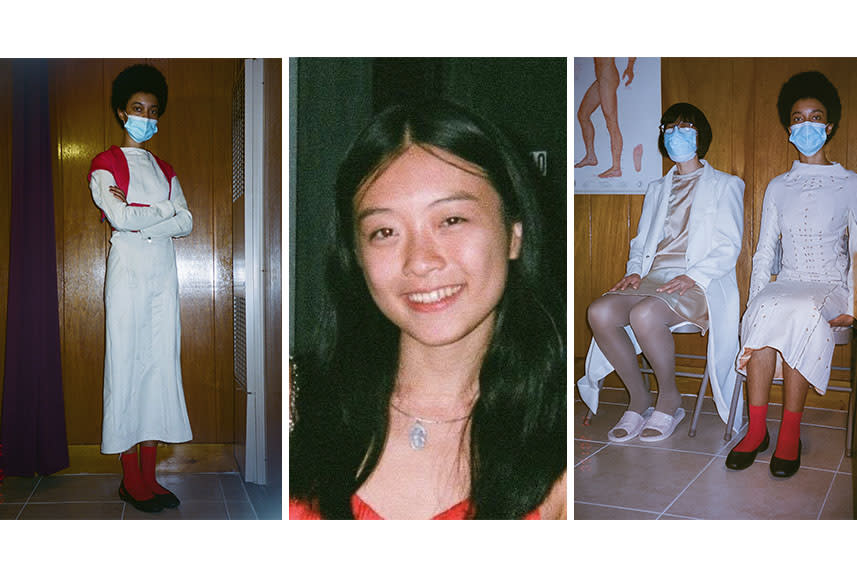
Name: Chu Shiao Michelle Han
Hometown: New York
Age: 22
Describe the concept behind your thesis collection: My thesis collection combines the science of Chinese traditional medicine and physical therapy to create fashion therapeutics. Accessories function as braces with acupressure and massage properties; garment seams map the body through the contrasting lines of anatomy and meridian channels; naturally dyed silk, wool and linen provide a sense of color therapy; nutritional clothing provides relief in the form of herbal pads and red bean weights; posture alignment and compression are incorporated into the silhouettes to aid certain lifestyles. In the process, I explore my Chinese-American heritage and strive to bring Eastern and Western medicine to a common understanding.
What were some of the inspirations, concepts or important world events that helped lead your thesis work? One inspiration for my thesis is a major challenge I find the Chinese healing community is facing in America. Chinese traditional medicine is labeled under “alternative medicine” in the English language and with that, there is a lot of skepticism that surrounds the practice. Growing up with health difficulties, I experienced the benefits of Chinese traditional medicine firsthand, even before seeing the way it was communicated in popular culture. My thesis project strives to combat the stigma attached to Chinese traditional medicine and share the practices with those who may want to experience it.
How has the pandemic affected your design aesthetic or process and the outcome of your thesis collection? Since my project was interlinked with the people around me and my community, it was affected by the pandemic as much as they were. I found that many of the pain points I was addressing were caused by working and being quarantined at home, being in unhealthy postures for extended periods of time. For me, the political side of the pandemic has also highlighted the conflicts between Eastern and Western medicine. The anti-Asian hate crimes that have resulted from stigmas attached to Asian culture have shown the gravity of the situation.
What do you hope to accomplish most in your career as a fashion designer? Through my thesis, I decided that a marker for my success would be if my therapeutic wearables were integrated and regularly worn. I believe this will continue to be my utmost priority — to be able to incorporate medicine into fashion products. Especially an application of medicine from a multicultural lens. I hope to use my experience growing up between two languages and outlooks on medicine to lessen the language barrier between Eastern and Western medicine. Ultimately, I feel motivated to accomplish my vision of bridging science into our everyday lives through art and design.
What are your plans for after graduation? I’m planning on working at my dad’s auto shop while I find a full-time position at preferably a company specializing in sportswear and/or innovative materials. Post-pandemic I dream of working at Ermenegildo Zegna in Italy and Issey Miyake in Japan. Making spacesuits at NASA or SpaceX is on the bucket list, too… Somewhere in between, I’d like to launch my brand and get my second degree in materials engineering.
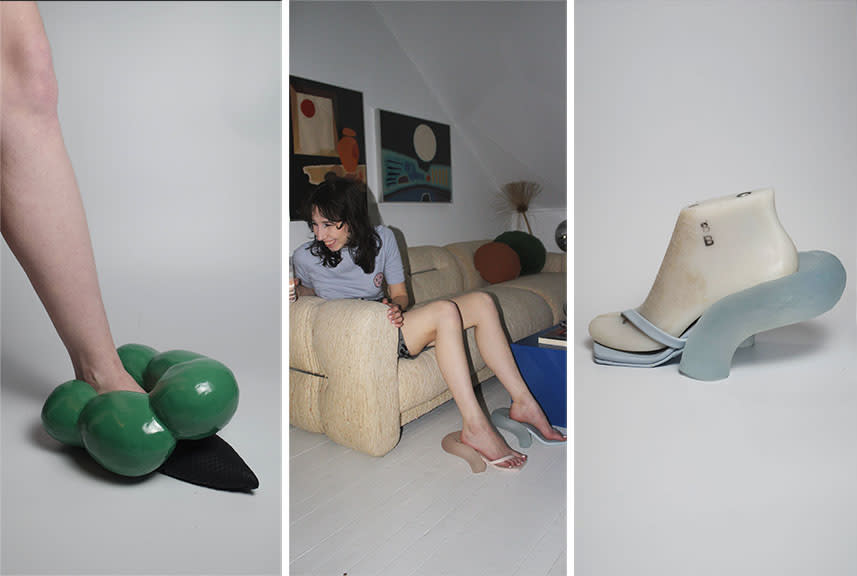
Name: Juliane (Julz) Iwerks
Hometown: Somerville, Mass.
Age: 23
Describe the concept behind your thesis collection: My thesis, “Fauxmobilia,” is a series of sculptural yet wearable shoes that camouflage into the home and build upon systems of reuse. The collection is a response to the boom in the home market that I experienced firsthand, loading vintage furniture into the backs of the Ubers at the height of the pandemic. As a designer and student of psychology, I found it reassuring to watch people turn to design for comfort and stimulation in a time of global stress, especially a younger market. I believe that by utilizing home materials in fashion products, it is possible to change consumer behavior to promote more thoughtful purchases and make products that are treated with the same care, specialty and permanence as traditional furniture.
What techniques are you most proud of in your thesis collection? Two of my designs are derived from broken seat backs of the most popular item in the NYC furniture resale market: the Cesca Chair by Marcel Breuer. The design is constructed with caning, which often breaks and requires replacement parts that yield waste. Other designs utilize trash-destined lampshades and resin for cantilever illusions.
Has the pandemic changed your outlook on the fashion industry? If so, how? The pandemic has emphasized the importance of pause. We were already seeing major changes in the understanding of “seasons” but I believe this pause truly reinvigorated the industry. I am now even more excited to watch the runways. As a psychology-minded person, I also must mention the importance of sleep and the tradition of neglecting it. We’re seeing an emphasis on self-care in the workplace and I’m happy to see positive practices come out of this trying year.
What are your plans for after graduation? I will continue my work in furniture resale, as well as explore my options in footwear design and psychological research. I plan to always work creatively and academically in some fashion. In the long run, my hope is to create a space that integrates a platform to share my designs, as well as those of other small designers; LGBTQIA-plus centric hospitality, specifically food and resale. Additionally, I’m a glassblower and would love to find ways to incorporate it into my footwear.
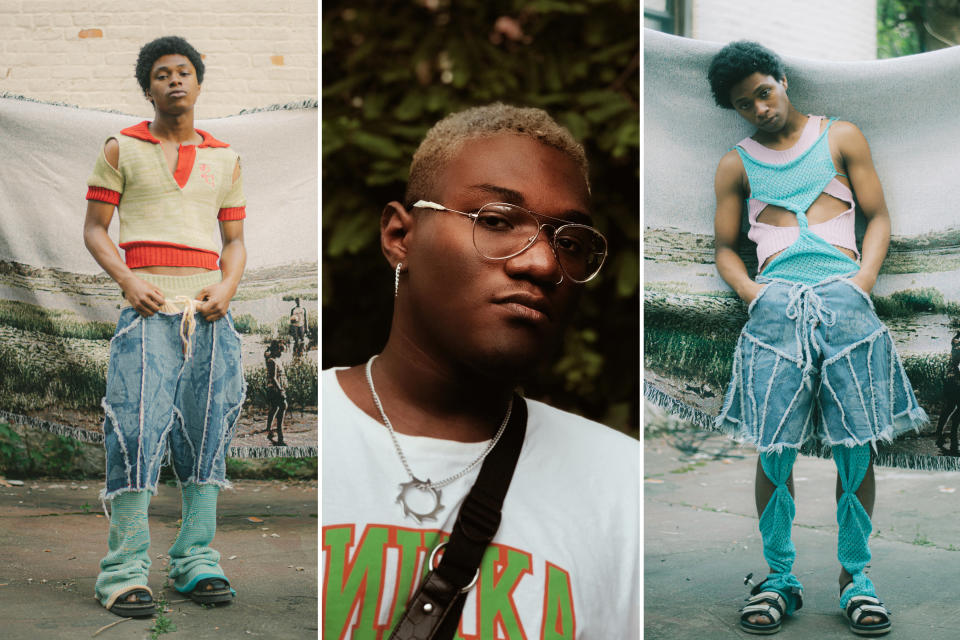
Name: Kadeem Lamorell
Hometown: Brooklyn
Age: 21
Describe the concept behind your thesis collection: Essentially, my thesis collection focuses on exploring the definition of masculinity through my experience growing up within both African American and Caribbean communities. I spent a lot of time observing the ways the two communities and cultures encompass and interpret masculinity when it comes to mannerisms, language, artistic expression and clothing choices. Through that, I looked into hip-hop culture and the imagery it created around masculinity. From that research, I examined queerness and homoerotic relationships in the Black community, while analyzing my connection to the Caribbean diaspora.
What were some of the inspirations, concepts, or important world events that helped lead your thesis work? A lot of my work has been inspired by my family and just taking the time to look through our archives. This gave me the chance to see how they dressed and how it’s evolved over the years. Seeing the exhibition “No Gyal Can Test” by Akeem Smith was a major turning point in my collection development and pushed me into seeking more of a raw, sexy, and confident vibe in my aesthetic. I was also inspired by the budding conversations around gender that my generation has facilitated. A lot of us are confronting the societal norms behind gender and dismantling that and I’m so happy to be a part of this reckoning.
Where have you been studying from while school is closed? Do you have plans to move after the pandemic? I’ve been studying from my family home in Flatbush. It’s been amazing to have them around me as a support system throughout the whole thesis process. With their help and my school, I was able to set up my own little studio here and continually work on development.
How has the pandemic affected your design aesthetic or process and the outcome of your thesis collection? The pandemic shifted the trajectory of my thesis a lot! Before it, I had plans to go back to Trinidad & Tobago, where all my family is from. I wanted to interview them, and film a little documentary about my family’s stories and their relationship with gender. While I didn’t get to do everything I planned, I feel the pandemic really caused me to look internally and reflect more deeply about my own experiences. I kept a journal thinking about all the times I was confronted with my perceived gender and how it changed me.
Has the pandemic changed your outlook on the fashion industry? If so, how? It’s definitely made me see fashion in a new light. It’s such a fragile industry and we’ve seen it kind of collapse in on itself over the course of this pandemic. So many brands have closed or cut back leaving little room for growth. I was definitely left a little jaded and anxious about whether or not I’d have a place in fashion after this. It pushed me to cultivate more creative relationships in my community and support smaller, local brands as they’re the ones most affected.
What do you hope to see change or improve in the fashion industry in the future? I want the industry to start supporting more Black and brown designers. So many of us have spent years in the shadows. There’s so much talent and creativity within us and the industry often doesn’t recognize us or give us the opportunities to grow. I hope to see more of us have prominent platforms and established businesses in the vein of Telfar or Christoper John Rogers.
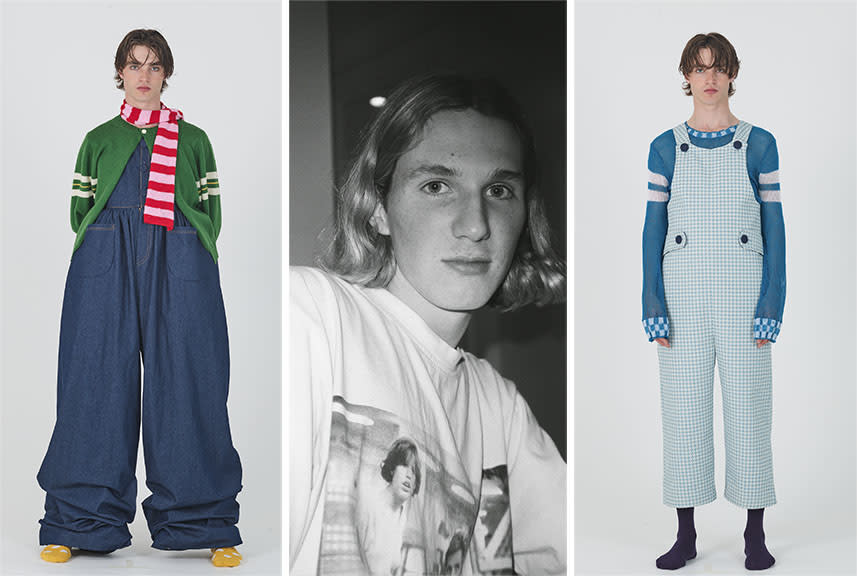
Name: Patrick Taylor
Hometown: London
Age: 21
Describe the concept behind your thesis collection: My work focuses on proportion and fit, with the intention of expanding the silhouette of men’s wear. After finding out that smocking, a technique of gathering fabric commonly seen in children’s wear, was historically worn by farmers up until the 20th century, I began to question why certain techniques that create volume are gendered. The idea that smocking originated as a men’s wear detail made me want to reintegrate these types of design details back into men’s wear. I played with how men’s wear fits the body, examining the mini-adult aesthetic of 1940s American children’s wear and its strong resemblance to English military uniforms.
Where have you been studying from while school is closed? Do you have plans to move after the pandemic? I have been studying at home in London this past year, where I plan on staying for the foreseeable future. When we are allowed to travel, I hope to go back to New York. I would love to see all of my class and teachers, who I have been working with remotely throughout my senior year.
How has the pandemic affected your design aesthetic or process and the outcome of your thesis collection? Studying online, at home, during lockdown meant I had limited options for fitting models. This affected the development and outcome of my thesis and led me to fit my samples on my 9-year-old brother. During these fittings I created an interplay between men’s wear and children’s wear and was able to examine the fit and proportions of my designs in greater depth. The way that the designs translated and distorted when fitted on my brother influenced the silhouette and energy of my final collection, giving it a playful aesthetic.
What do you hope to accomplish most in your career as a fashion designer? I’d like to design garments that expand the current silhouette of men’s wear by integrating design details that have long been associated with femininity. I would like to create garments which give more people a greater amount of choice and bridge the gap between what is considered masculine and feminine.
What do you hope to see change or improve in the fashion industry in the future? I’d like to see the fashion industry highlight brands that prioritize design, construction and materiality over high-output production of garments. I hope to see a greater focus on smaller businesses and a move away from fast fashion. I want to be part of the emerging young designers who care about the ethics behind their fabrics and production, focusing on the environmental impact of my garments, without comprising on design.
What are your plans for after graduation? After graduation I’d like to take some time to reflect on my collection. I hope to apply for an MA, but I think that I would benefit from working in the fashion industry and to learn from the creatives who have helped to inspire me. I’d love the opportunity to work for a brand such as JW Anderson, who is known for his interplay between masculinity and femininity, or Molly Goddard, whose craftsmanship creates inspiring silhouettes. Both have created a new modern interpretation of men’s and women’s wear.
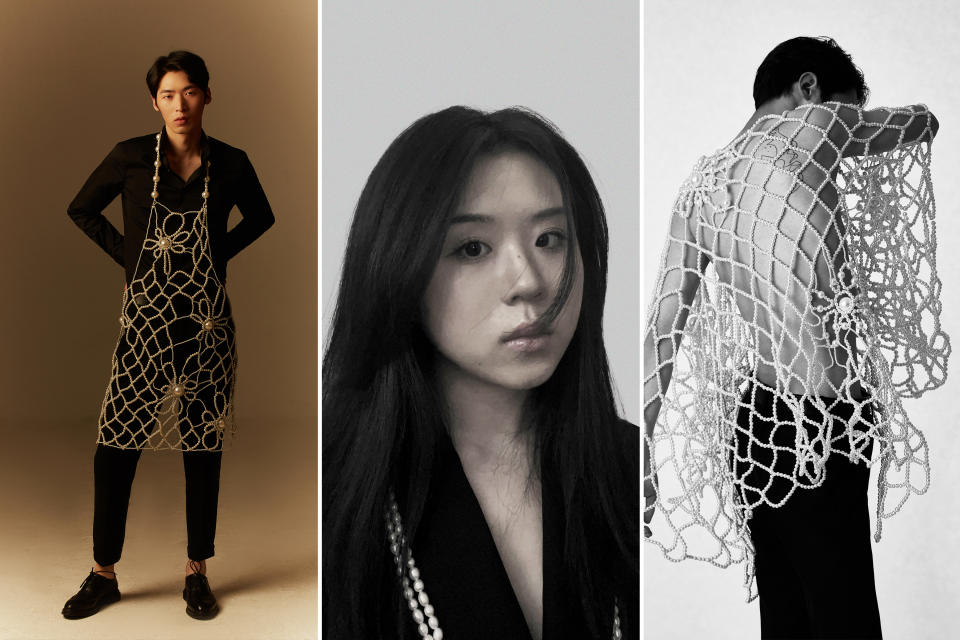
Name: Lily Xu
Hometown: Wenzhou, China
Age: 22
Describe the concept behind your thesis collection: My collection, called “Gen/tle/man,” is a men’s pearl accessories collection that represents the fluid energy between masculinity and femininity. The symbolism and history of pearls inspired me to challenge the traditional classism pearl represents and reimagine the possibility of pearl accessories.
What techniques are you most proud of in your thesis collection? I’m most proud of the way I beaded garment-scale jewelry pieces without any support of fabric. I then embroidered pearl flowers onto these garments as jewelry pieces, to let the body and skin form a direct relationship with the pearls.
Where have you been studying from while school is closed? Do you have plans to move after the pandemic? I went back to my hometown Wenzhou, China, when school closed and I’m interested in seeking further education in fashion so I am planning to move to London after the pandemic.
Has the pandemic changed your outlook on the fashion industry? If so, how? Definitely it changed my view on the fashion industry and as a designer I don’t believe in the system the industry has created in the past — I don’t think it’s necessary for everybody to do the same amount of fashion shows and collections every year. As the next-generation designers, we don’t have to follow the system — we can form our own schedule and work at our own pace.
What do you hope to accomplish most in your career as a fashion designer? As an Asian fashion designer I want to support my people and my community. The racism toward the Asian community breaks my heart and I think designers have a responsibility to speak up because fashion is a powerful tool and we can use our power and voice to make a change.
What do you hope to see change or improve in the fashion industry in the future? I hope to see change in racism and not just as a PR strategy but actually offer people jobs and opportunities in the industry.
Who do you hope is reading this and what is your message to them? Timothée Chalamet, if you are reading this my message to you is the pearl robe will look good on you.
Best of WWD
Sign up for WWD's Newsletter. For the latest news, follow us on Twitter, Facebook, and Instagram.

